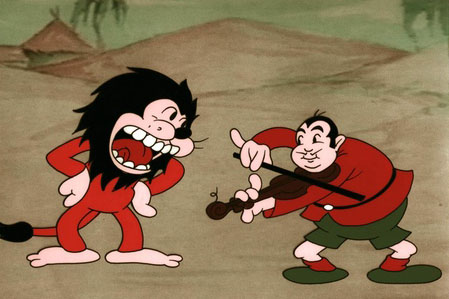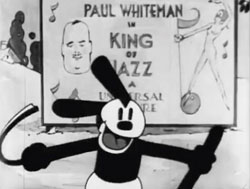
Paul Whiteman was the Leviathan of the dance-band business all through the 1920’s, and into the 1930’s.
And I’m not just talking about his weight!
So, of course, animated cartoons, newly spiced up with music, sound effects and even dialogue, and having become as topical as all get-out, were going to take off on him. And he doesn’t seem to have minded one bit!
Indeed, Whiteman assented to there being an animated sequence in The King of Jazz (1930), one of those plotless all-talking-all-singing-all-dancing-let’s-cram-all-our-contract-players-onto-the-screen-so-that-they-can-show-the-public-that-they-can-talk-sing-and-or-dance affairs.Universal sprang for all the trimmings–including two-strip Technicolor, Broadway’s own John Murray Anderson, a bevy of songwriters, a larger bevy of dancers, and the entire Paul Whiteman ensemble. The result was a box-office disappointment, although a trimmed-down reissue in 1933 did better.
The film has been recently restored in a miraculous way (see it on the big screen, if it comes to a museum or repertory theater near you) and a lavish new book on the making of the film (and the process of its recent restoration) has just been published. I highly recommend it.
As for the animation sequence – this being a Universal production, it made sense that the animation production would go to Walter Lantz and Bill Nolan. These folks had only recently inherited Oswald the Lucky Rabbit, and were satisfying Universal’s desire to have cartoons to go with their feature films.
Universal had not bought established music publishers (as had Warner Bros. or M-G-M), nor did they set up their own publishing house (as had Paramount). So, they didn’t have the ability to plug new songs form their musicals–such as they were at the time.
The animated sequence–showing how Whieman was “crowned” as King of Jazz–is more of a feast for the ear than for the eye. The soundtrack features the full Whiteman orchestra and ensemble, and has feature bits for Joe Venuti (violin), Eddie Lang (guitar), Bing Crosby (providing a singing voice for the animated Whiteman), and the Rhythm Boys (with some of their scat).
The orchestra plays their arrangement in their usual style, with a reference to Arthur Fields’ successful 1914 song “Aba Daba Honeymoon” leading into Whiteman’s being “crowned” with an animated coconut, with the lump turning into the crown marking him as the King of Jazz.
(By the way, Oswald gets a cameo in, dancing to the rhyrhmic strains in the company of a cobra.)
Having started “The King of Jazz” off with a bang, it makes sense that Lantz and Nolan would take of on Whiteman once again, within less than a year after having done the opening of the feature film.
My Pal Paul (1930) opens with a hefty silhouette “conducting” music from “The King of Jazz” in front of a poster advertising the film.
Turns out it’s only Oswald, and his efforts are not widely appreciated in the hobo jungle where he dwells. As a result, he decides to End It All–by hanging himself.
That result goes awry anyway–but is ended by a visit by a motoring Paul Whiteman, potato-head and all. There are a number of musical interludes, which allow for exposure of several of the hit sons from “The King of Jazz”. These include “The Song of the Dawn” (heard over the credits), “A Bench In The Park”, “Ragamufin Romeo”, “It Happened In Monterey” and “Happy Feet”.
Eventually, Paul gets so exasperated with Oswald’s antics that he decides to hang the Lucky Rabbit himself. This does not work as planed, as Whiteman winds up pulling down the tree and everything. A sarcastic “My Pal!’, then it’s “boop-boop-be-doop, that’s Oswald!” — over and out.
 Whiteman had gone back East and reduced the size of his entourage by the time this cartoon was in production. So, we don’t get the full Whiteman orchesra–we get a group of Local 47 cleffers, directed by Jamed Dietrich, who is said to have come from within he Whiteman organization to do musical scores for Lantz for several years. And even though Bing Crosby had stayed out here when Whiteman went East, he is not heard whenever Whiteman has to “sing”. Some other singer gets to provide Whiteman’s “voice”.
Whiteman had gone back East and reduced the size of his entourage by the time this cartoon was in production. So, we don’t get the full Whiteman orchesra–we get a group of Local 47 cleffers, directed by Jamed Dietrich, who is said to have come from within he Whiteman organization to do musical scores for Lantz for several years. And even though Bing Crosby had stayed out here when Whiteman went East, he is not heard whenever Whiteman has to “sing”. Some other singer gets to provide Whiteman’s “voice”.
Please Note: I’d be remiss if I didn’t mention my colleagues Tom Klein and Steve Stanchfield who have written previous posts about King Of Jazz and My Paul Paul here and here. I highly recommend you check them out again!
Next Week: Some other cartoons–from other studios–give Paul Whiteman a gentle razz.



 James Parten has overcome a congenital visual disability to be acknowledged as an expert on the early history of recorded sound. He has a Broadcasting Certificate (Radio Option) from Los Angeles Valley College, class of 1999. He has also been a fan of animated cartoons since childhood.
James Parten has overcome a congenital visual disability to be acknowledged as an expert on the early history of recorded sound. He has a Broadcasting Certificate (Radio Option) from Los Angeles Valley College, class of 1999. He has also been a fan of animated cartoons since childhood.











































Whiteman had a great dance band. For years his orchestra was put down by jazz critics and historians. Yes, a lot of his output was not jazz but when the band performed jazzy pop tunes he made sure to have jazz musicians who could play it such as Jimmy Dorsey, Steve Brown, Frank Trumbauer and of course, Bix Beiderbecke.
That cartoon sequence was the first marriage of sound and color (albeit 2 strip) in animation.
This is a wonderful sequence and, yes, you are probably right when you say that this film is more a wonderful experience to the ear than the eye; hey, I’m not complainin’. I’d love to catch this at a theater when it comes this way, but more than that, I hope someone has the good sense to bring this to physical media sometime soon, perhaps adding “MY PAL, PAUL” as an extra.
Wonderfully loopy bits of music like this are why I like cartoons of this period, as well as wanting to further explore the music of that period that inspired this and were enjoyed by young people of this era. I only have this two disk “anthology” of sorts regarding the Whiteman bands, but the real joy is the music that accompanies these cartoons. I’m beginning to appreciate the Lantz output during the 1930’s more and more. Thanks for this!
Best place to start exploring Paul Whiteman’s music of this period–in fact, of the period between 1920 and 1935-is on the Internet Archive.
Just Google “Paul Whiteman Archives”, and yuu’ll have access to everything from that fiften-year span that Whiteman recorded for Victor and for Colmbia, as well as some airchecks of his “Kraft Music Hall” shows of 1933 and 1934.
Another excellent source for music of the 1920’s and 1930’s is YouTube. Try the channel “Prozoot”–great selection of music, and superb dubbings from clean 78s and transcriptions.
Once you explore around, you’ll find what you like.
Paul Whiteman and his orchestra were big in every way from (gently putting it) the pleasingly plump maestro, his generosity, hius inventiveness, his and his band’s popularity, and the band’s large size, oh, and the long length of a lot of their pioneering records-Gershwin’s famous “Rhapsody in Blue” and in-house arranger Ferde Grofe’s “The Grand Canyon Suite”. Clip CLIP clopetiy clop..
I wonder if anyone else noticed that there’s a tiny snippet of “Rhapsody In Blue” at around 56 seconds? Whiteman’s orchestra, or course, was famous for orchestrating Gershwin’s original piano composition and performing the piece publicly for the first time.
Remembering the scene in Laurel and Hardy’s “Below Zero” in which Stan and Ollie are playing their duet on portable organ and bass fiddle on a street corner; and a woman in the apartment above them opens her window, leans out, and calls to Ollie, “Oh, Mr. Whiteman!”
Mention should also be made of the 1935 Disney classic “Music Land,” where Whiteman is caricatured as a saxophone, king of the Isle of Jazz.
How the mighty had fallen. Post-World War II(and almost a generation since Whiteman was relevant),he was the musical director for the ABC Radio network and did various jobs in TV’s early days. He hosted Paul Whiteman’s TV Teen Club,originating from Philadelphia and seen via kinescope on the network(even on radio after the fact). Notable during the five year run(49′-’54) was early exposure for teen idol Bobby Rydell,Charlie Gracie, an appearance by 8 yr. old Leslie Uggams and,at the end,Dion DiMucci. Also,doing announcing jobs( primarily hawking sponsor Tootsie Rolls),was a young Dick Clark. Many of the tech crew from Philly’s WFIL would later work on the original Bandstand,hosted by Bob Horn(an infamous history all of its own)and eventually,Dick Clark’s version of Bandstand,which would go national and act as the conduit of rock ‘n roll songs rising from local radio to coast-to -coast exposure.
While trying to making a modern day comparison to a once-popular bandleader hosting a show aimed at the children(and grandchildren) of his original audience,try to think of Paul McCartney hosting the rap-fueled New Years Eve show on Fox. Eww! But back then,it evidently worked. Whiteman was very engaged in his new audience,playing the part of the hip but old dude(Whiteman would be in his 60s) for fun and entertainment.